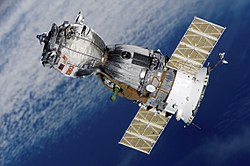Salvaging Salyut 7
The effort to salvage Salyut 7 was, in the words of author David S. F. Portree, "one of the most impressive feats of in-space repairs in history". [4] As the crew approached the inert station, they saw that its solar arrays were pointing randomly as it rolled slowly about its long axis. They used a handheld laser rangefinder to judge their distance, and conducted a fly-around inspection to be certain the exterior was intact. Dzhanibekov noted that the thermal blankets on the transfer compartment had turned a dull gray from prolonged exposure to sunlight.
Dzhanibekov piloted his ship to intercept the forward port of Salyut 7, matched the station's rotation and achieved soft dock with the station. Upon achieving hard dock—the first time a Soyuz had docked with an inert space station [5] —the crew confirmed through the electrical connectors in the docking collars that the Salyut 7 electrical system was dead. They carefully sampled the air in the station before opening the hatch. The station air was very cold, but breathable. Frost covered the walls and apparatus. The cosmonauts wore winter garb, including fur-lined hats, as they entered the station.
The first order of business was to restore electric power. Two of the eight batteries were destroyed, the rest fully discharged. Dzhanibekov determined that a sensor in the solar array pointing system had failed, preventing the batteries from recharging. A telemetry radio problem prevented the TsUP (mission control center) from detecting the problem. Salyut 7 had quickly run down its batteries, shutting down all its systems and accounting for the break in radio contact. [6] The cosmonauts set about recharging the batteries and used Soyuz T-13 to turn the station in order to point its solar arrays to the sun.
On June 10, 1985 they turned on the air heaters. The cosmonauts relied on the Soyuz T-13 air regeneration system until they could get the Salyut 7 system back in order. On June 13, 1985 the attitude control system was successfully reactivated. This was cause for jubilation, as it meant Kosmos 1669 (a Progress supply spacecraft) bearing replacement parts could dock with Salyut 7. The station's water tanks thawed by the end of June 1985 – freezing had destroyed the water heater, so the cosmonauts used a powerful television light to heat fluids. Wall heaters were turned on only after all the frost had evaporated, in order to prevent water from entering equipment. Normal atmospheric humidity was achieved only at the end of July 1985, nearly two months after docking.
